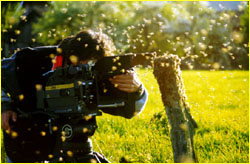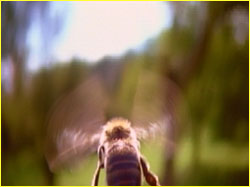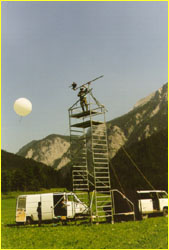
|
 |
|
If you watched the NOVA program "Tales From the Hive," you're probably wondering how the filmmakers secured some of that astonishing footage of honeybees. How did they get closeups of bees in flight? Of a queen mating on the wing? Of the inside of a brood cell deep within a hive? In this engaging interview, enhanced by images taken during the making of the film, cinematographer Wolfgang Thaler reveals the tricks he and his team employed to capture the most intimate honeybee behavior. NOVA: How did you get those close-up shots of a bee in flight? Thaler: During the preparation phase, the thought of trying to get those kinds of pictures gave me a big headache, because it was clear that we had to shoot bees in flight—first to experience the flight of the bee emotionally, and secondly, to do justice to the standard set forth by the international nature film genre.
The next step was to find out how I could fly with the bees, because they are fast. I told myself, if I can't fly with the bee, then the bee has to fly with me—that is, with the camera, directly in front of the lens. It was like the work at a clockmaker's. We used a pair of tiny tweezers to form a wafer-thin wire. We then tied the bee up with this—very carefully, because we did not want to harm the bee, and we wanted to make sure it had the freedom to move its wings. A special kind of arrangement enabled us to fix the wire to the camera. The bees didn't volunteer for this procedure, and the hardest part was to avoid getting stung. Before the flight, the bee got a sip of honey from a pipette, and after successfully landing, it was set free again. That's how I could film the bees in flight from the front, back, and side. All I had to do was move with the camera and the flying bee through the landscape and jump from flower to flower. This learning process took more than a year, however. This procedure was even harder with the queen, because she is easily injured and not as robust as a worker bee. Also there is only one queen per bee population.
Thaler: The mating of the queen takes place somewhere out in nature, in flight, at places where drones assemble and wait everyday for a queen to come by. Such a place could be anywhere, in the woods, a meadow, or even a football stadium. Some beekeepers know these places. To date, scientists have not been able to figure out why drones assemble only in certain places or how the queens locate these spots. We had to find such a place that was flat enough to build a tower, because the mating takes place at a height of about 65 to 100 feet. We built a tower about 26 feet high and mounted the camera at the end of a six-and-a-half-foot-long extension. With this we were able to set the camera into a 360-degree rotation. (The queen has to be flying to mate.) We "tied" the queen in front of the camera, then we had to lure the drones from their altitude of 100 feet or so down to the level of our queen. For this purpose, we filled a weather balloon with helium, tied queens in a cage underneath that balloon, and let it rise. The idea was to draw the drones down with the queens' pheromones.
NOVA: How long did it take to get the toughest, most valued shots? Thaler: It seems absurd, but the obviously easiest shots posed the greatest difficulties. For example, it was almost impossible to get the drones in front of the camera—simple things like having them crawl through the picture from left to right. They were far too shy, and because of their large eyes, the camera and the light must have posed a threat. The worker bees were not much disturbed by light and camera; when they had a job to do in the hive, they accomplished it. From the beginning of the project, the biggest challenge was to shoot the inside of the hive without interrupting the natural behavior of the bees. With every day of the shoot, we became richer in experience, and so I saved myself the most difficult shots for the end. These included the queen laying her eggs (filmed from the inside of the honey cell), the storage of pollen, and the feeding of the larva with royal jelly. Again we had a lucky day, because queens are the shyest of all bees, especially young queens. As soon as something disrupts their environment, they stop their natural behavior and hide among thousands of bees. NOVA: What are you working on now? Thaler: In February 2000, we will begin shooting a film on salt. Salt was once called "the white gold," because it was the engine of many civilizations. Most people today take this crystal for granted, but there are still places in the world where people have to wring salt from nature, under the toughest conditions. As my next project, I'd love to do a film about ants, to enter their fascinating world. In cinematographic terms, this will be a big challenge for me, because these insects are very small and fast, and they live mostly in inaccessible places. Continue: Preparing everything The Making of | Anatomy of a Hive The Buzz About Bees | Dances With Bees Resources | Transcript | Site Map | Tales from the Hive Home Editor's Picks | Previous Sites | Join Us/E-mail | TV/Web Schedule About NOVA | Teachers | Site Map | Shop | Jobs | Search | To print PBS Online | NOVA Online | WGBH © | Updated October 2000 |
 Filmmaker Wolfgang Thaler gets up close and personal
with honeybees during the making of the NOVA film
"Tales From the Hive."
Filmmaker Wolfgang Thaler gets up close and personal
with honeybees during the making of the NOVA film
"Tales From the Hive."
 After much preparation, Thaler succeeded in getting
sequences like this one, in which it almost appears as
if he's hanging off the hind feet of a flying
honeybee.
After much preparation, Thaler succeeded in getting
sequences like this one, in which it almost appears as
if he's hanging off the hind feet of a flying
honeybee.
 One of the most extraordinary scenes in the film is
this of a drone mating in mid-flight with a queen.
One of the most extraordinary scenes in the film is
this of a drone mating in mid-flight with a queen.
 Since mating takes place high off the ground, the
film crew built a temporary tower to capture the
elusive moment on film.
Since mating takes place high off the ground, the
film crew built a temporary tower to capture the
elusive moment on film.